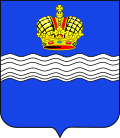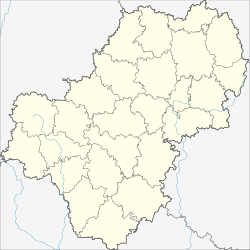Kaluga
City in Kaluga Oblast, Russia From Wikipedia, the free encyclopedia
Kaluga (Russian: Калу́га, IPA: [kɐˈɫuɡə]) is a city and the administrative center of Kaluga Oblast, Russia. It stands on the Oka River 150 kilometers (93 mi) southwest of Moscow. Its population was 337,058 at the 2021 census.[14]
Kaluga
Калуга | |
|---|---|
 Space museum, Rocket Vostok, House store of Rakov, Kaluga from a birds-eye view, Trolleybus, corner of Moskovskaya and Dostoyevskogo st. | |
| Coordinates: 54°33′N 36°17′E | |
| Country | Russia |
| Federal subject | Kaluga Oblast[1] |
| First mentioned | 1371[2] |
| Government | |
| • Body | City Duma[3] |
| • City Head[4] | Dmitry Denisov[5] |
| Area | |
• Total | 170.5 km2 (65.8 sq mi) |
| Elevation | 190 m (620 ft) |
| Population | |
• Total | 324,698 |
| 340,851 (+5%) | |
| • Rank | 55th in 2010 |
| • Density | 1,900/km2 (4,900/sq mi) |
| • Subordinated to | City of Kaluga[1] |
| • Capital of | Kaluga Oblast,[1] City of Kaluga[1] |
| • Urban okrug | Kaluga Urban Okrug[9] |
| • Capital of | Kaluga Urban Okrug[9] |
| Time zone | UTC+3 (MSK [10]) |
| Postal code(s)[11] | 248xxx |
| Dialing code(s) | +7 4842[12] |
| OKTMO ID | 29701000001 |
| City Day | Second Saturday of September[13] |
| Website | www |
Kaluga's most famous resident, the space travel pioneer Konstantin Tsiolkovsky, worked there as a school teacher from 1892 to 1935. The Tsiolkovsky State Museum of the History of Cosmonautics in Kaluga is dedicated to his theoretical achievements and to their practical implementations for modern space research, hence the motto on the city's coat of arms: Колыбель Космонавтики, Kolybélʹ kosmonávtiki ("The Cradle of Space-Exploration").
History
Summarize
Perspective
Kaluga, founded in the mid-14th century as a border fortress on the southwestern borders of the Grand Duchy of Moscow, first appears in the historical record in chronicles in the 14th century as Koluga; the name comes from Old Russian kaluga is "bog, quagmire".[15] During the period of Tartar raids it was the western end of the Oka bank defense line. The Great stand on the Ugra River was fought just to the west. In the Middle Ages Kaluga was a minor settlement owned by the Princes Vorotynsky. The ancestral home of these princes lies southwest of the modern city.
On 19 January 1777, the Kaluga drama theatre opened its first theatrical season, established with the direct participation of the Governor-General Mikhail Krechetnikov.[16]
Kaluga is connected to Moscow by a railway line and by the ancient roadway, the Kaluga Road (now partly within Moscow (as the Old Kaluga Highway), partly the A101 road).[17] This road offered Napoleon his favored escape route from the Moscow trap in the fall of 1812. But General Kutuzov repelled Napoleon's advances in this direction and forced the retreating French army onto the Old Smolensk Road, previously devastated by the French during their invasion of Russia.
On several occasions during the Russian Empire Kaluga was the residence of political exiles and prisoners such as the last Crimean khan Şahin Giray (1786), the Kyrgyz sultan Arigazi-Abdul-Aziz (1828), the Georgian princess Thecla (1834–1835), and the Avar leader Imam Shamil (1859–1868).[18]
The German army briefly occupied Kaluga during the climactic Battle of Moscow, as part of Operation Barbarossa. The city was under full or partial German occupation from October 12 to December 30, 1941. In 1944, the Soviet Government used its local military buildings to intern hundreds of Polish prisoners of war — soldiers of the Polish underground Home Army — whom the advancing Soviet front had arrested in the area around Vilnius.
Demographics
| Year | Pop. | ±% |
|---|---|---|
| 1897 | 49,513 | — |
| 1926 | 49,425 | −0.2% |
| 1939 | 89,396 | +80.9% |
| 1959 | 134,235 | +50.2% |
| 1970 | 210,906 | +57.1% |
| 1979 | 265,013 | +25.7% |
| 1989 | 311,399 | +17.5% |
| 2002 | 334,751 | +7.5% |
| 2010 | 324,698 | −3.0% |
| 2021 | 337,058 | +3.8% |
| Source: Census data | ||
As of the 2021 Census, the ethnic composition of Kaluga was:[19]
|
Administrative and municipal status
Kaluga is the administrative center of the oblast.[1] Within the framework of administrative divisions, it is, together with seventy-two rural localities, incorporated as the City of Kaluga—an administrative unit with the status equal to that of the districts.[1] As a municipal division, the City of Kaluga, together with one rural locality in Ferzikovsky District (the selo of Novozhdamirovo), is incorporated as Kaluga Urban Okrug.[9]
Economy
The Kaluga Turbine Plant is located here as is Kaluga Machine Works, which manufactures track machines for railways. In recent years, Kaluga has become one center of the Russian automotive industry, with a number of foreign companies opening assembly plants in the area:[20]
On 28 November 2007, Volkswagen Group opened a new assembly plant in Kaluga, which further expanded by 2009. The investment has reached more than 500 million Euro. As of 2014[update] the plant assembled the Volkswagen Passat, Škoda Fabia and Škoda Rapid.[21]
On 15 October 2007, the Volvo Group broke ground on a new truck assembly plant, that was inaugurated on 19 January 2009,[22] with a yearly capacity of 10,000 Volvo and 5,000 Renault trucks.[23]
On 12 December 2007, PSA Peugeot Citroën announced its decision to build a new assembly plant in Kaluga.[24]
Transportation
The city is served by the Grabtsevo Airport. Since 1899, there has been a railway connection between Kaluga and Moscow.[25]
Public transportation is represented by the trolleybuses, buses, and marshrutkas (routed taxis).
- ZiU-682 trolleybus
- ZiU-682 trolleybus
- BKM-321 low-floor trolleybus
- Kaluga Airport
- Kaluga Railway Station
Climate
Summarize
Perspective
Kaluga has a humid temperate continental (Köppen climate classification: Dfb), with warm and humid summers; and long, cold and snowy winters. Winter extreme records can be as low as −45 °C (−49 °F), while summer heat may reach up +40 °C (104 °F), but normal variation is between −5 °C (23 °F) and −20 °C (−4 °F) during winter and between 15 °C (59 °F) and 30 °C (86 °F) during summer in Kaluga.
| Climate data for Kaluga, Russia (period 1961–1990) | |||||||||||||
|---|---|---|---|---|---|---|---|---|---|---|---|---|---|
| Month | Jan | Feb | Mar | Apr | May | Jun | Jul | Aug | Sep | Oct | Nov | Dec | Year |
| Mean daily maximum °C (°F) | −6.6 (20.1) |
−5.0 (23.0) |
0.4 (32.7) |
10.3 (50.5) |
18.7 (65.7) |
21.5 (70.7) |
23.0 (73.4) |
21.9 (71.4) |
15.7 (60.3) |
9.0 (48.2) |
0.7 (33.3) |
−3.7 (25.3) |
7.2 (45.0) |
| Daily mean °C (°F) | −10.1 (13.8) |
−9.0 (15.8) |
−3.5 (25.7) |
5.7 (42.3) |
12.7 (54.9) |
15.8 (60.4) |
17.5 (63.5) |
16.3 (61.3) |
10.9 (51.6) |
5.4 (41.7) |
−1.9 (28.6) |
−6.6 (20.1) |
4.4 (39.9) |
| Mean daily minimum °C (°F) | −13.5 (7.7) |
−12.9 (8.8) |
−7.4 (18.7) |
1.0 (33.8) |
6.7 (44.1) |
10.1 (50.2) |
12.0 (53.6) |
10.7 (51.3) |
6.1 (43.0) |
1.8 (35.2) |
−4.5 (23.9) |
−9.5 (14.9) |
0.1 (32.2) |
| Average precipitation mm (inches) | 39 (1.5) |
33 (1.3) |
35 (1.4) |
39 (1.5) |
43 (1.7) |
77 (3.0) |
80 (3.1) |
71 (2.8) |
55 (2.2) |
50 (2.0) |
53 (2.1) |
55 (2.2) |
630 (24.8) |
| Source: www.meteoinfo.ru
"www.meteoinfo.ru". Retrieved 3 September 2012. | |||||||||||||
Notable people
This section needs additional citations for verification. (April 2025) |
Kaluga's most famous resident was rocket science pioneer Konstantin Tsiolkovsky.
Other notable people include:
- Sergei Avagimyan, former professional footballer. Born in Russia, he played for the Armenian national football team.
- Alexander Amfiteatrov
- Yuri Averbakh, chess grandmaster
- Mykola Azarov
- Pafnuty Chebyshev, mathematician
- Alexander Chizhevsky
- David Edelstadt
- Alexander Gretchaninov, Russian-American composer
- Jonah of Hankou
- Andrei Kalaychev
- Valery Kobelev, ski jumper
- Mikhail Linge
- Pavel Popovich, cosmonaut, the only person to receive two honorary citizenships of Kaluga (1962 and 1964)[26]
- Larisa Popugayeva
- Nikolai Rakov
- Imam Shamil
- Nikolay Skvortsov, swimmer
- Yuliya Tabakova
- Georgy Zhukov
- Olesya Zykina, 400m athlete
- Bulat Okudzhava, lived and taught Literature in public school in the 1950s.
- Serafim Tulikov
- Ivan Kuliak
- Stanislav Kunyaev
Twin towns – sister cities
Partner cities
In addition to twin towns, Kaluga cooperates with:[27]
 Clearwater, United States (1992)
Clearwater, United States (1992) Xianyang, China (2000)
Xianyang, China (2000) Tula, Russia (2002)
Tula, Russia (2002) Oryol, Russia (2003)
Oryol, Russia (2003) Smolensk, Russia (2003)
Smolensk, Russia (2003) Makhachkala, Russia (2012)
Makhachkala, Russia (2012) Tsiolkovsky, Russia (2016)
Tsiolkovsky, Russia (2016) Ryazan, Russia (2017)
Ryazan, Russia (2017) Tambov, Russia (2017)
Tambov, Russia (2017)
Gallery
- Kaluga. Main Square
- Kaluga. Polman House
- Kaluga Region Drama Theatre building
- Kaluga. Eastern archway at the Administration Building
- Kaluga. Moscow State Technical University (local branch)
- Streetside stores in Kaluga
- Kaluga. Region administration
- Trolleybus in Kaluga
- Astronautics Museum
References
External links
Wikiwand - on
Seamless Wikipedia browsing. On steroids.





















